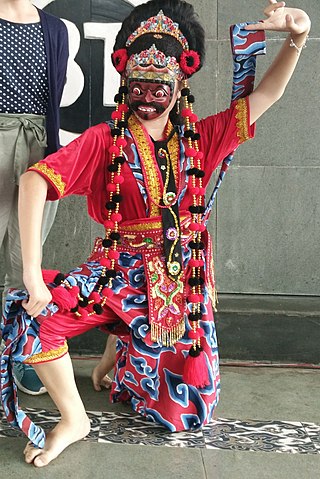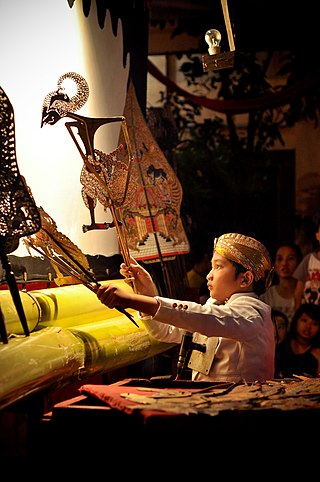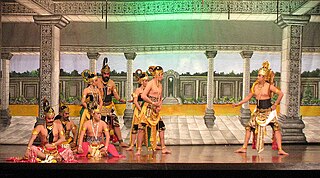
Gamelan is the traditional ensemble music of the Javanese, Sundanese, and Balinese peoples of Indonesia, made up predominantly of percussive instruments. The most common instruments used are metallophones and a set of hand-drums called kendang, which keep the beat. The kemanak, a banana-shaped idiophone, and the gangsa, another metallophone, are also commonly used gamelan instruments on Bali. Other notable instruments include xylophones, bamboo flutes, a bowed string instrument called a rebab, and a zither-like instrument called a siter, used in Javanese gamelan. Additionally, vocalists may be featured, being referred to as sindhen for females or gerong for males.

Wayang is a traditional form of puppet theatre play originating from the Indonesian island of Java. Wayang refers to the entire dramatic show. Sometimes the leather puppet itself is referred to as wayang. Performances of wayang puppet theatre are accompanied by a gamelan orchestra in Java, and by gender wayang in Bali. The dramatic stories depict mythologies, such as episodes from the Hindu epics the Ramayana and the Mahabharata, as well as local adaptations of cultural legends. Traditionally, a wayang is played out in a ritualized midnight-to-dawn show by a dalang, an artist and spiritual leader; people watch the show from both sides of the screen.

The culture of Indonesia has been shaped by the interplay of indigenous customs and diverse foreign influences. With over 1,300 distinct ethnic groups, including significant Austronesian and Melanesian cultures, contributing to its rich traditions, languages, and customs, Indonesia is a melting pot of diversity. Positioned along ancient trade routes between the Far East, South Asia, and the Middle East, the country has absorbed cultural practices influenced by Hinduism, Buddhism, Confucianism, Islam, and Christianity. These influences have created a complex cultural tapestry that often differs from the original indigenous cultures.

Cirebon is a port city on the northern coast of the Indonesian island of Java. It is the only coastal city of West Java, located about 40 km west of the provincial border with Central Java, approximately 297 km (185 mi) east of Jakarta, at 6°43′S108°34′E. It had a population of 296,389 at the 2010 census and 333,303 at the 2020 census; the official estimate as at mid 2023 was 341,980.

Rangda is the demon queen of the Leyaks in Bali, according to traditional Balinese mythology. Terrifying to behold, the child-eating Rangda leads an army of evil witches against the leader of the forces of good — Barong. The battle between Barong and Rangda is featured in a Barong dance which represents the eternal battle between good and evil.

Topeng is a dramatic form of Indonesian dance in which one or more mask-wearing ornately costumed performers interpret traditional narratives concerning fabled kings, heroes, and myths, accompanied by gamelan or other traditional music instruments. Topeng dance is a typical Indonesian dance that can be found in various regions of Indonesia. Topeng dance has the main characteristic that the dancers use masks to cover their faces. The dance will usually be performed by one dancer or a group of dancers.

Barong is a panther-like creature and character in the Balinese mythology of Bali, Indonesia. He is the king of the spirits, leader of the hosts of good, and enemy of Rangda, the demon queen and mother of all spirit guarders in the mythological traditions of Bali. The battle between Barong and Rangda is featured in the Barong dance to represent the eternal battle between good and evil.

Wayang wong, also known as wayang orang, is a type of classical Javanese and Balinese dance theatrical performance with themes taken from episodes of the Ramayāna or Mahabharāta. Performances are stylised, reflecting Javanese court culture:
Wayang wong dance drama in the central Javanese Kraton of Yogyakarta represents the epitome of Javanese aesthetic unity. It is total theatre involving dance, drama, music, visual arts, language, and literature. A highly cultured sense of formality permeates every aspect of its presentation.

Cirebon Regency is a regency (kabupaten) of West Java Province of Indonesia. The town of Sumber is its capital. It covers 1,076.76 km2 and had a population of 2,068,116 at the 2010 census and 2,270,621 at the 2020 census; the official estimate as at mid 2023 was 2,360,441. These area and population figures exclude those of Cirebon City, which is an independent administration, although totally surrounded by the regency on its landward side.

Balinese dance is an ancient dance tradition that is part of the religious and artistic expression among the Balinese people of Bali island, Indonesia. Balinese dance is dynamic, angular, and intensely expressive. Balinese dancers express the stories of dance-drama through bodily gestures including gestures of fingers, hands, head, and eyes.

Dance in Indonesia reflects the country's diversity of ethnicities and cultures. There are more than 1,300 ethnic groups in Indonesia. Austronesian roots and Melanesian tribal forms are visible, and influences ranging from neighboring Asian and even western styles through colonization. Each ethnic group has its own dances: there are more than 3,000 original dance forms in Indonesia. The old traditions of dance and drama are being preserved in the numerous dance schools which flourish not only in the courts but also in the modern, government-run or supervised art academies.

Hyang is a representation of the supreme being, in ancient Java and Bali mythology. The spiritual entity can be either considered divine or ancestral. The reverence for this spiritual entity can be found in the folk religions of Java and Bali, such as the Sunda Wiwitan, Kejawen, Kapitayan, and Gama Tirta. The realm where Hyang resides is called the Kahyangan, which is an Old Javanese term that means "the abode of Hyang", "part of Hyang", or "heaven".

Cirebonese mask dance is a local indigenous art form of Cirebon in Java, including Indramayu and Jatibarang, West Java and Brebes, Central Java. It is called mask dance because the dancers use masks when dancing. There is a lot of variety in Javanese mask dance, both in terms of the dance style and the stories to be conveyed. This mask dance can be performed by solo dancers, or performed by several people.

Gandrung is a traditional dance from Indonesia. Gandrung has many variations and is popular in Bali, Lombok, and Eastern Java among the Balinese, Sasak, and Javanese. The most popular variation is gandrung from the Banyuwangi region in the eastern peninsula of Java; thus, the city is often referred to as Kota Gandrung, or "the city of gandrung". Originally a ritual dance dedicated to the goddess of rice and fertility, Dewi Sri, it is currently performed as a social dance of courtship and love in communal and social events, or as a tourist attraction. Gandrung Sewu Festival is held at Banyuwangi annually.

Wayang kulit is a traditional form of shadow puppetry originally found in the cultures of Java and Bali in Indonesia. In a wayang kulit performance, the puppet figures are rear-projected on a taut linen screen with a coconut oil light. The dalang manipulates carved leather figures between the lamp and the screen to bring the shadows to life. The narratives of wayang kulit often have to do with the major theme of good vs. evil.

It is quite difficult to define Indonesian art, since the country is immensely diverse. The sprawling archipelago nation consists of 17,000 islands. Around 922 of those permanently inhabited, by over 1,300 ethnic groups, which speak more than 700 living languages.

Candi bentar, or split gateway, is a classical Javanese and Balinese gateway entrance commonly found at the entrance of religious compounds, palaces, or cemeteries in Indonesia. It is a candi-like structure split perfectly in two to create a passage in the center for people to walk through. In contrast to the very ornate shape and decoration of the main faces, the sides of the passage are left completely plain. The passage is usually elevated with a flight of stairs to reach it. A candi bentar is commonly found in Java, Bali, and Lombok.

Barong dance is a style of traditional Balinese from Bali, Indonesia. The dance demonstrates about the mythological depiction of animals that have supernatural powers and the ability to protect humans. Barong is the king of the spirits, leader of the hosts of good, and the enemy of Rangda, the demon queen and mother of all spirit guarders in the mythological traditions of Bali. The Barong dance featured a battle between Barong and Rangda to represent the eternal battle between good and evil.

Indonesian theatre is a type of art in the form of drama performances that are staged on a stage, with a distinct Indonesian nuance or background. In general, theatre is an art that emphasizes the performing arts that are displayed in front of a large crowd. In other words, theater is a form of visualisation of a drama that is staged on the stage and watched by the audience. Indonesian theatre includes the performing arts of traditional theater and modern theatre located in the territory of Indonesia. Some examples of Indonesian theater are Arja, Wayang, Wayang wong, Lenong, Ludruk, Janger, Randai and others. Theatre in Indonesia can also be referred to as regional or ethnic theatre, because it originates and develops from 1,300 ethnic cultures in Indonesia.



















